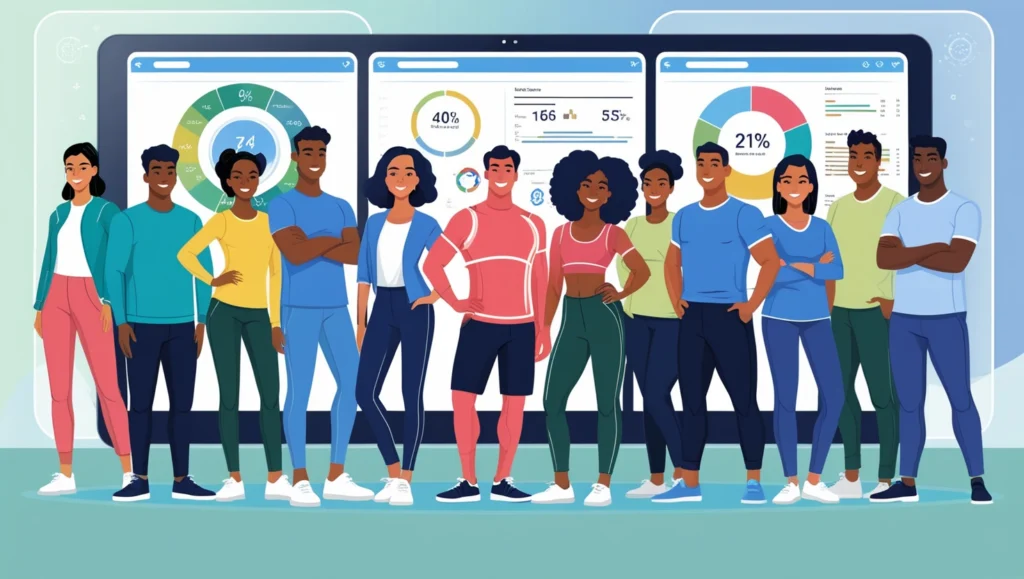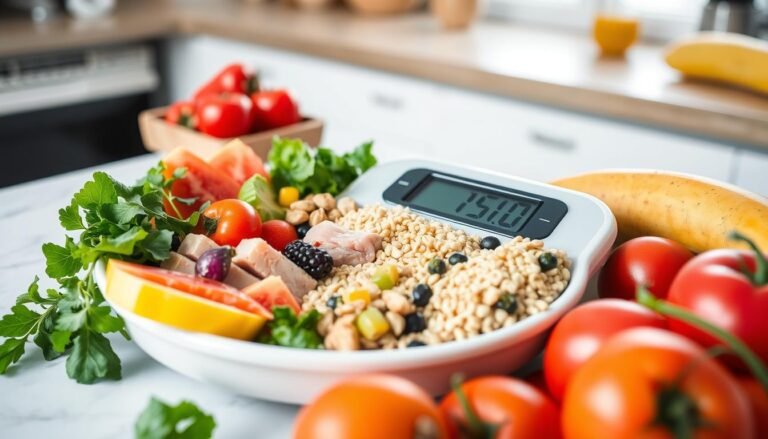The world of health and wellness is always changing. We’re always looking for better ways to measure our health. The Body Mass Index (BMI) has been around for a while, but now, the Body Roundness Index (BRI) is becoming more popular. It offers a more detailed look at our health.
So, what is BRI, and how is it different from BMI? Let’s dive into this interesting topic. We’ll see how BRI could be a game-changer in health measurements.

Key Takeaways
- Body Roundness Index (BRI) is a new way to measure body composition. It uses waist circumference and height to check for belly fat.
- BRI is seen as a better choice than BMI for spotting health risks like heart disease.
- Studies show BRI can predict heart disease risk. It can also spot insulin resistance and metabolic syndrome.
- BRI gives a fuller picture of body shape and fat distribution. These are key for heart and metabolic health.
- Using BRI in healthcare can help catch health risks early. It can also guide prevention efforts.
Understanding Body Roundness Index and Its Significance
The Body Roundness Index (BRI) was introduced in 2013. It’s a new way to measure body composition. It looks at height, weight, and waist size to understand body shape and health risks better than BMI.
Origins and Development of Body Roundness Index (BRI)
The idea of BRI came from Johannes Kepler’s work on planets. He studied how planets move in space. This led to the idea of BRI, which shows how round a person’s body is, from egg-shaped to round.
Key Components of BRI Calculation
- Height
- Weight
- Waist Circumference
Geometric Principles Behind Body Roundness Index (BRI)
The BRI uses a math concept called eccentricity. It shows how round a body is, from 0 (perfect circle) to 1 (straight line). This gives a detailed look at body shape, unlike BMI.
The Body Roundness Index looks at more than just waist size and height. It offers a detailed body shape analysis. This is better than just looking at waist-to-height ratio and abdominal obesity indicator.
How Body Roundness Index Differs from BMI
The body mass index (BMI) has been used since the 1980s to check health. But it doesn’t look at fat distribution or body composition well. The Body Roundness Index (BRI) is a better way to check body composition and health risks.
BRI uses hip and waist sizes, along with height and weight, to guess total and belly fat. This gives a more accurate view of obesity than BMI. BMI just puts people into weight categories based on their height and weight.
A study with data from the National Health and Nutrition Examination Survey showed BRI’s strength. It used data from around 33,000 Americans. The study found BRI is better at figuring out body composition and weight categories than BMI.
BRI shows a bell curve when graphed, unlike BMI’s flat parts. This means BMI might not work for everyone’s body shape and size. Diana Thomas created BRI, seeing the body as an oval, not a cylinder. This makes it more inclusive for measuring body composition.
BRI is seen as a good step towards better body composition measurement. It’s easier to use than special scales or scans. BRI looks at belly fat, which is key for health. It’s better at showing metabolic health than traditional BMI.
“BRI offers a more accurate estimation of obesity-related health risks, such as type 2 diabetes and heart disease, compared to BMI.”
The Science Behind Body Roundness Index Measurements
The Body Roundness Index (BRI) is a new way to measure body composition. It’s different from the Body Mass Index (BMI) because it looks at waist size and height. This gives a detailed view of body shape and fat distribution.
Waist Circumference and Height Ratio
The BRI uses waist size and height to calculate a score. This score shows how body fat is spread out. A higher score means more abdominal fat and higher health risk screening.
Mathematical Formula and Calculations
The BRI formula is simple but powerful. It uses waist size and height to give a single score. The formula is: BRI = 364.2 – 365.5 × (1 – (waist circumference / (π × height))^2)^0.5. This score shows how rounded the body is, with lower scores meaning a more rounded body fat distribution.
Interpreting BRI Results
The BRI score ranges from 0 to 6. Higher scores mean a less rounded body shape. People with scores close to 0 might have more anthropometric measurements and health risks. Those with higher scores are likely to have lower health risks. This helps doctors and patients understand body fat better and make health choices.
Health Risk Assessment Using Body Roundness Index (BRI)
Research shows the Body Roundness Index (BRI) is good for checking health risks. A big study with nearly 33,000 U.S. adults found a “U-shaped” link between BRI scores and death risk.
The study’s results were striking. People with a BRI under 3.4 had a 25% higher death risk. Those with a BRI over 6.9 had a 49% higher risk than those in the healthy range. This shows how crucial it is to keep a BRI in the right range to avoid obesity-related health risks and stay healthy.
The study also found BRI is rising, especially among women, older people, and Mexican Americans. This makes BRI a key metabolic health marker and cardiovascular risk assessment tool for different groups.
| BRI Range | Mortality Risk |
|---|---|
| BRI | 25% increased risk |
| BRI > 6.9 | 49% increased risk |
| Optimal BRI Range | Reduced health risks |
The study’s findings highlight the need for a healthy BRI range. Health experts can use BRI as a simple test to guess death risk. This can help them start early to tackle obesity-related health risks and keep hearts healthy.

BRI as a Predictor of Cardiovascular Disease
Recent research has found a strong link between body roundness index (BRI) and heart disease risk. A study with nearly 10,000 adults in China showed a link. Those with a higher BRI level over 6 years had up to a 163% higher risk of heart disease.
Research Findings on Heart Health
The study, from the China Health and Retirement Longitudinal Study, gave us important insights. It grouped participants by their BRI changes: low-stable, moderate-stable, and high-stable. The results were striking:
- The moderate-stable BRI group had a 61% higher risk of heart disease than the low-stable group.
- The high-stable BRI group had a 163% higher risk of heart disease than the low-stable group.
- Those in the moderate-stable and high-stable BRI groups also faced a higher risk of stroke and heart attacks.
Risk Factors and Prevention Strategies
The study shows BRI could predict heart disease risk. People with a high and stable BRI often have other risk factors like high blood pressure and diabetes. This highlights the need for regular heart health assessments and tackling abdominal obesity indicators like BRI.
Understanding BRI’s link to cardiovascular disease risk helps doctors create better prevention plans. Regular BRI checks, along with other health markers, help people live healthier lives. This reduces the risk of serious heart problems.
Advantages of Using BRI for Health Screening
The body roundness index (BRI) is better than BMI for health screenings. It shows where fat is in the body, like around the belly. This area is linked to diseases like type 2 diabetes.
BRI can tell the difference between muscle and fat. BMI can be wrong for people with a lot of muscle. BRI gives a clearer picture of body fat, which is key for checking obesity and health risks.
Also, BRI is simple to use and understand. It’s great for health checks in many places. Healthcare teams can use BRI to better understand a person’s health risk screening, body composition evaluation, and obesity assessment.
| Metric | Advantage |
|---|---|
| Abdominal Fat Evaluation | BRI provides a more accurate assessment of central adiposity, which is a key indicator of metabolic health risks. |
| Muscle-Fat Differentiation | BRI overcomes the limitations of BMI in assessing individuals with high muscle mass. |
| Ease of Measurement | BRI requires simple waist and height measurements, making it a practical tool for routine health screenings. |
More studies are needed to prove BRI’s worth. But, its benefits in health risk screening, body composition evaluation, and obesity assessment are clear. It’s a valuable tool for health experts.

Body Composition Analysis Through Body Roundness Index (BRI)
The Body Roundness Index (BRI) is great at measuring abdominal fat. This is key for checking metabolic health. Too much fat around the midsection is a big risk for heart disease.
BRI gives a clear view of abdominal fat. This helps spot people at risk for metabolic and heart diseases.
Measuring Abdominal Fat Distribution
BRI is a top tool for checking abdominal fat. It’s different from BMI because it looks at waist size and height. This gives a better idea of body fat distribution.
Impact on Metabolic Health
Too much fat around the belly, as Body Roundness Index (BRI) shows, is linked to health issues. For every BRI unit increase, the risk of hypertension goes up by 17%. People with the highest BRI have a 53% higher risk of high blood pressure.
BRI is better at predicting high blood pressure than waist size or waist-to-height ratio. It’s a key metabolic health marker and abdominal obesity indicator in health care.
“BRI ranges from 1 to 15, showing how round someone is around their middle. A study of 33,000 adults over 20 years found BRI more accurate than BMI for weight status.”
| Metric | AUC for Predicting Hypertension |
|---|---|
| Body Roundness Index (BRI) | 0.67 (95% CI: 0.65–0.70) |
| Waist Circumference (WC) | 0.68 (95% CI: 0.66–0.70) |
| Waist-to-Height Ratio (WHtR) | 0.68 (95% CI: 0.66–0.71) |
| Body Mass Index (BMI) | 0.67 (95% CI: 0.64–0.69) |
| A Body Shape Index (ABSI) | 0.58 (95% CI: 0.56–0.60) |
The table shows BRI, waist size, and waist-to-height ratio are just as good at predicting high blood pressure. They do better than BMI and ABSI. This shows BRI’s value in checking abdominal body fat distribution and its effect on metabolic health and abdominal obesity.
Latest Research and Clinical Studies on Body Roundness Index (BRI)
Recent studies have shown that the Body Roundness Index (BRI) is a great tool for health checks. A big study of 33,000 U.S. adults found a strong link between BRI and death rates. This shows BRI could be a key indicator of health.
The study also found that BRI has been getting higher over 20 years. This points to a growing obesity problem in the U.S. It shows how important BRI is for tracking health and risks.
In Iran, a study looked at BRI and A Body Shape Index (ABSI) in overweight and obese people. It found ABSI linked to high blood pressure and triglycerides. But BRI didn’t show strong links to metabolic syndrome risk factors.
| Metric | Findings |
|---|---|
| Metabolic Syndrome Prevalence | 25% worldwide, with higher rates in certain age, race, and sex groups |
| Iranian Population with Metabolic Syndrome | Nearly one-third of the over-20 population |
| Study Participants | 347 overweight and obese individuals aged 20-50 in Tabriz, Iran |
| ABSI Associations | Higher ABSI linked to higher blood pressure and triglyceride levels |
| BRI Associations | No significant associations found between BRI and metabolic syndrome risk factors |
These results suggest ABSI might be better at predicting metabolic syndrome risks than BRI. Yet, BRI still has value in checking body composition and health. This is especially true in the face of growing obesity research and health risk assessment.
“BRI looks at waist circumference and height to reflect fat proportion in the body, providing a more comprehensive picture of an individual’s health status compared to traditional measures like BMI.”
As scientists look for new ways to tackle obesity and health risks, BRI stays a valuable tool. It’s useful for both healthcare professionals and researchers.
Implementing BRI in Healthcare Settings
The Body Roundness Index (BRI) is getting more attention for its role in health risk assessment. It’s not yet common, but its simplicity and ability to spot obesity risks make it promising. It could change how we approach health in the future.
Professional Guidelines
Healthcare groups and associations can help make BRI a standard tool. They can create rules for measuring and using BRI. This way, BRI can fit easily into current health checks and screenings.
Practical Applications
Adding BRI to electronic health records (EHRs) makes it even more useful. It lets doctors quickly see a patient’s BRI during visits. This helps in making better treatment plans and preventing health problems.
| Metric | Advantages | Limitations |
|---|---|---|
| Body Mass Index (BMI) | Widely used and understood Simple to calculate | Does not account for body fat distribution May misclassify individuals with high muscle mass |
| Body Roundness Index (BRI) | Considers waist circumference for a more accurate assessment of body fat distribution Better predictor of obesity-related health risks | Requires additional measurements (waist circumference) Less widely known and adopted compared to BMI |
Using BRI in healthcare can improve how we evaluate body composition and screen for health issues. It could lead to better health care and outcomes for patients.
Future Implications of BRI in Health Assessment
The Body Roundness Index (BRI) is set to change health assessment. It could soon be a key tool for health risk prediction, obesity management, and preventive healthcare. BRI gives a better look at body composition and fat distribution. This could help spot health risks earlier and more accurately than today’s methods.
BRI is different from Body Mass Index (BMI) because it uses waist circumference and height. This makes it better at showing body roundness. Studies show that a higher BRI is linked to higher risks of heart disease, diabetes, and other health problems.
Research also shows BRI is better than BMI for predicting metabolic syndrome and colorectal cancer. This means BRI could give a fuller picture of someone’s health and risk. As BRI becomes more common in healthcare, it could help prevent health problems before they start.
But, more research is needed to fully understand BRI’s role. The way BRI is measured and its values can be tricky. Some worry that the term “roundness” might be seen as negative or triggering.
Despite these issues, BRI’s potential in health risk prediction and obesity management is huge. It could change how we look at and tackle health risks. This could lead to better preventive healthcare strategies.
| Metric | Description | Relationship to Health Risks |
|---|---|---|
| Body Mass Index (BMI) | Classifies individuals into categories: underweight, normal weight, overweight, or obese. | Can misclassify well-conditioned athletes as overweight or obese despite low body fat levels. |
| Body Roundness Index (BRI) | Uses height and waist circumference to determine a value that reflects the roundness of the body. | A BRI value of 2.5 or higher is associated with increased risk of heart disease, diabetes, and metabolic disorders. |
In conclusion, BRI’s future in health assessment looks bright. As research confirms its benefits, it could become a key tool for health risk prediction, obesity management, and preventive healthcare. But, more studies and improvements are needed to overcome current challenges and ensure its use in healthcare.
Conclusion
The body roundness index (BRI) is a big step forward in health measurement. It gives a detailed look at body composition and health risks. This could help improve health checks and public health plans.
Studies show BRI is linked to health issues like colorectal cancer and heart disease. It’s better at predicting health risks than BMI or waist circumference. This makes BRI a strong tool for checking health status and disease risk.
As healthcare grows, using BRI could lead to better health care and outcomes. It helps in identifying and treating obesity and related health problems. This way, we can work towards a future where these issues are handled better.
FAQ
What is Body Roundness Index (BRI)?
Body Roundness Index (BRI) is a new way to measure body shape. It uses waist size and height to show how much belly fat you have. It’s seen as better than Body Mass Index (BMI) for spotting health risks.
How is BRI calculated?
To find your BRI, you need to measure your waist and height. Then, a formula uses these numbers to show your body shape. The lower the number, the rounder your body and the higher the health risk.
What are the advantages of BRI over BMI?
BRI is better than BMI because it looks at waist size too. This helps figure out how much fat you have, not just your weight. It’s great for athletes and people with different body types because it’s more accurate.
How is BRI useful for health risk assessment?
Studies show BRI is good for checking health risks. It links higher BRI levels to more deaths and heart disease. It’s especially good at measuring belly fat, which is key for health.
What is the future of BRI in healthcare?
BRI is still new in healthcare but it’s promising. It’s easy to use and might be more accurate than current methods. It could become a standard tool in clinics with the right training and technology.




